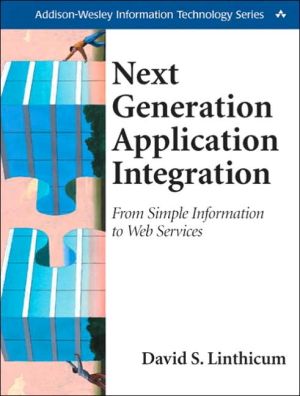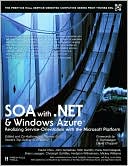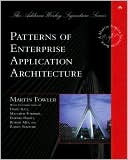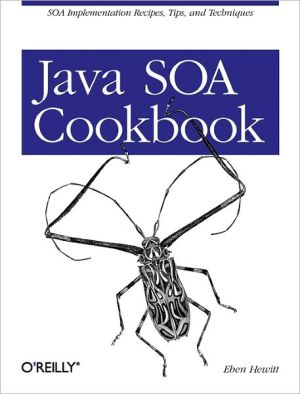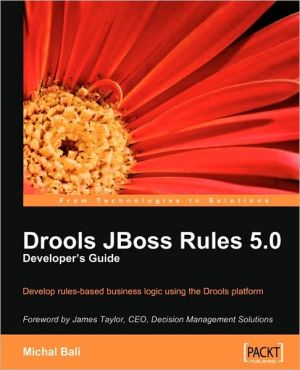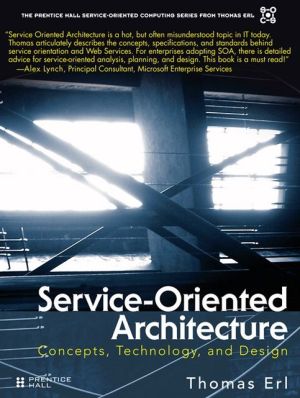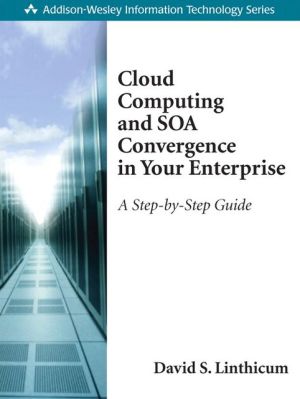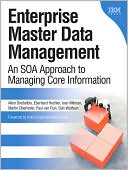Next Generation Application Integration: From Simple Information to Web Services
"Linthicum provides an insightful overview of the services-integration issues that will enable you to capitalize on current and future integration technologies. He also dives deep into the key Web services technologies for implementing the next generation integration architecture. Highly recommended for those thinking of moving from traditional EAI to Web services."\ --Dr. Ravi Kalakota, CEO, E-Business Strategies Author of Services Blueprint: Roadmap for Execution\ For a majority of...
Search in google:
"Linthicum provides an insightful overview of the services-integration issues that will enable you to capitalize on current and future integration technologies. He also dives deep into the key Web services technologies for implementing the next generation integration architecture. Highly recommended for those thinking of moving from traditional EAI to Web services."—Dr. Ravi Kalakota, CEO, E-Business StrategiesAuthor of Services Blueprint: Roadmap for ExecutionFor a majority of businesses, application integration is an outright failure. Most companies' computer systems are labyrinthine at best and self-destructive at worst. With the arrival of Web services, the new service-oriented middleware technology standard, and increasingly complex and challenging problem domains, it's time to take application integration to the next level.In Next Generation Application Integration distributed computing and application-integration expert David S. Linthicum describes the effect that this new generation of middleware will have on traditional application-integration efforts. Using key industry examples and case studies, Linthicum reveals the techniques and practices that are necessary to revolutionize data-sharing for any company—from sole-proprietorship to Fortune 500.In this book you'll find a thorough discussion of today's most advanced application-integration concepts, approaches, technologies, and solutions. Written with the technical manager and enterprise architect in mind, this book addresses essential application integration issues such as:Strategies for dealing with complex problem domains Forward-looking approaches to ensure long-termsolutions that are right for your company Techniques for implementation of new Web services middleware Introductions to the appropriate technologies for next generation application integration Scenarios for Web services integration Support concepts outlined by case studies and real-world examples Descriptions and analyses of the different types of Web service integration—standards, implementation, and enabling technology Full analysis of Web services and integration, including the relationship between EAI and Web services How to leverage both vertical and horizontal application-integration standardsIf you're responsible for managing or implementing application-integration middleware, Next Generation Application Integration will prove to be an indispensable resource.
In the last several years application integration, at least the notion, has worked its way into most information technology departments. This has been driven by a number of emerging developments including the need to expose information found in existing systems to the Web, the need to participate in electronic marketplaces, the necessity the integrate their supply chain, and more importantly, just enabling their existing enterprise systems to finally share information and common processes.\ By now we know that application integration is important, thus there is not much need for me to restate that here. What is not as well understood is the amount of planning and coordination that needs to occur in order to pull off application integration today, EAI or B2B, this, despite the availability of some pretty good technology that can make short work of joining systems together.\ Moreover, while many are interested in application integration few have taken the time to read books such as this, or the books I've written in the past, to better understand both the limitations and the opportunities. More often than not application integration architects are driven more by the hype around the emerging standards and technology and less by their business needs and technology requirements. The end result is many failed projects, more due to lack of knowledge than lack of technology.\ In essence application integration is less about J2EE versus .NET, and more about understanding the requirements and future growth of the problem domain, a not-so-sexy activity that is all to often left on the side of the road, choosing instead to "management by magazine."\ Indeed application integration is moreof an all-encompassing concept, consisting of, but not limited to metadata, business logic, interfaces, performance management, business processes, workflow, information processing, database integrity, standards strategies, vertical subsystems, accountability, application design, and middleware technology. Application integration is a strategic activity and technology set that can enable an organization to run much more efficiently, and in most instances provide a significant competitive advantage. Why a New Book?\ If you've been following my writings for the last several years you'll know that this is the third book on application integration, and perhaps the most significant. We need a new book for a few reasons:\ First, the arrival of a new service-oriented middleware technology standard, web services. As we move further into the world of application integration, we're finding that application service-based approaches make sense for many problem domains. I've stated that in both previous books. Now with the advent of a new service-based approach, web services, we now have another opportunity to put that into perspective. I'll talk about web services and how they related to application integration, albeit this is not a book about web services, just the proper application of web services in application integration problem domain.\ Second, there is a need to take application integration to the next level. The first book on application integration, Enterprise Application Integration, the first of its kind, covered the basic concepts of allowing two or more business systems to share processes and data. That book was written for the rank beginner since EAI, at least the notion and buzzword, was new. The next book, B2B Application Integration: eBusiness-Enable Your Enterprise, really extended the concepts put forth in the first book to the inter-enterprise problem domain, which reuses many of the same approaches and technologies, but does require knowledge of old and new B2B standards and technologies including\ This book is all about looking at advanced application integration concepts, approaches, and technologies, with many topics typically not covered in the previous books or any other books for that matter. We'll be looking at how to approach very complex and challenging application integration problem domains, and leverage forward-looking concepts and technology, including how to understand your problem domain, determine your requirements, create a logical application integration architecture, and most importantly, backing the correct grouping of application integration technologies into your solution to create an infrastructure that is strategic to the success of your organization. Target Audience\ This books is written with the technical manager and enterprise architect in mind, those that live on the frontlines of technology everyday and have to make key technology decisions that can make or break their businesses. This does not mean, however, that developers and IT executives won't benefit from this information, especially when it comes to understand application integration in context of their day-to-day activities. What this Book is, What this Books is Not\ At its essence this is an information technology strategy book with some detailed technology discussion, just enough technology content to support the notions put forth. This book is looking to take an important topic, application integration, to the next level by suggesting certain ways to view the problem that may not have been understood in the past.\ This means we'll focus on higher-level approaches and solutions, rather than spending a lot of time describing the technologies. There are plenty of other books that do that. For example, while I may talk about the Java Message System (JMS) in terms of the general ideas behind this important standard, at its use in an application integration solution set, you can obtain more details by reading the 200+ page standard found on www.javasoft.com, or other books specifically on JMS. The same can be said about .NET, J2EE, eb\ Indeed, I will cover the enabling technologies by focusing on their value in solving the application integration problem. For most of you, further research into these technologies or standards won't be required; there will be enough information here. Others, however, looking for implementation level details will have to take a deeper dive using further research outside the scope of this book. Organization\ This book follows a clearly structure it will make your reading experience more valuable.\ There are 4 parts:\ \ \ \ Part I: Types of Application Integration\ Part II: Application Integration Technology\ Part III: Application Integration Standards\ Part IV: Advanced Topics\ \ In Part I I'm focusing on the types of application integration approaches you'll find in your problem domain, in other words general approaches to sharing information, processes and application services between any number of applications. It's important that you read this section since it sets up concepts for the rest of the book. Also, if you've read my previous books you'll see how my thinking is morphing after building and implementing a lot of application integration technology.\ In Part II we'll talk about application integration technology including middleware, and specifically application integration middleware including integration servers and application servers. Once again, we will discuss the technology in terms of their uses within the world of application integration. If you're a middleware god, perhaps you can skip this section, else it will be a good review.\ In Part III we'll talk about application integration standards. If you've been in this world at all you'll know that standards are the way people are looking to approach this problem rather than vendor solutions. In this section I'll talk about the issues with doing that, as well as describe the standards that are relevant to application integration.\ In Part IV we'll talk about how you need to approaches your own application integration problem domain, including procedures, methodologies, and techniques that you can employ to improve your chance of success. Moreover, we'll address advanced application integration topics, including the advent of vertically oriented application interaction technology as well as the advanced use of metadata. Other StuffThe Appendixes. There I'll find some useful reference information supporting the core content of the book. While in many cases people skip the appendixes, I urge you to read through what's there.\ So, if you're moving on to Chapter 1, relax. It will be a painless process, perhaps fun. See you at the end.
PrefaceAcknowledgmentsCh. 1Approaching Application Integration1Pt. ITypes of Application IntegrationCh. 2Information-Oriented Application Integration25Ch. 3Business Process Integration-Oriented Application Integration55Ch. 4Service-Oriented Application Integration77Ch. 5Portal-Oriented Application Integration99Pt. IIApplication Integration TechnologyCh. 6Middleware Basics115Ch. 7Middleware Types and Application Integration: What Works Where?137Ch. 8Java-Based Middleware Standards and Application Integration177Ch. 9Integration Services and Application Integration191Ch. 10Adapters and the J2EE Connector Architecture217Pt. IIIApplication Integration StandardsCh. 11XML, XSLT, and Application Integration235Ch. 12ebXML and Application Integration259Ch. 13BPEL4WS and Application Integration279Ch. 14UCCnet and Rosettanet: Supply Chain Integration Standards293Ch. 15Soap, WSDL, and UDDI, OH My . . . Web Services Foundations and Application Integration311Ch. 16Other Standards325Pt. IVAdvanced TopicsCh. 17The "Verticalization" of Application Integration Technology337Ch. 1812 Steps to Application Integration369Ch. 19Leveraging Ontologies and Application Integration393Ch. 20Application Integration Manifesto405App. APIP Specification435App. BWhere XML Fits With Application Integration453App. CKnowledge-Oriented Middleware461Bibliography463Index471
